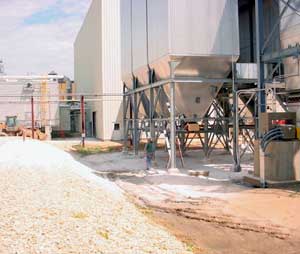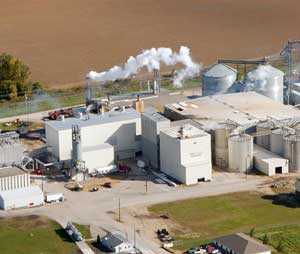Creating an Energy Island





February 9, 2007
BY Dave Nilles
Corn Plus is an island surrounded by a sea of corn in south-central Minnesota. For more than a decade, the state's first dry-grind ethanol plant continues to grow and evolve.
The 749 predominantly farmer investors in Corn Plus have witnessed many industry firsts since the plant began producing ethanol in November 1994. General Manager Keith Kor, who joined the Winnebago-based plant in its first year, says Corn Plus was one of Delta-T's first process designs. The facility also included one of ICM Inc.'s first distillers grains dryers, he says. The facility also features one of Minnesota's first E85 pumps, which has been operating for 10 years.
The plant is now becoming well-known for its aggressive technological firsts, most of which are aimed at reducing fossil fuel consumption. It's Kor's long-term goal to eliminate the need for natural gas and coal-fired electricity by creating an energy island where only corn goes in and energy comes out. "My goal is to be energy independent—to shut the gas and electricity off," Kor says. "As other plants double production, I want to get as much as I can out of my existing plant."
The existing plant has already expanded its production during Kor's tenure. Initially opening with a 15 MMgy nameplate capacity, Corn Plus underwent a debottlenecking process in 1997 that boosted production to 21 MMgy. A full-scale expansion, led by Delta-T in September 2001, added another 20 MMgy in capacity. Minor debottlenecking has since increased production capacity to its current 45 MMgy.
The 2001 expansion essentially added a second ethanol plant to the site. The facility now has two distillation systems, two sets of evaporators and two sets of distillers grains dryers, Kor says. Although the growth in capacity has naturally led to an increase in energy usage, Kor still appears well on his way to achieving his energy independence goal.
The plant's natural gas consumption has been cut in half due to an innovative fluidized bed reactor, which was an industry first when it started up in 2005. Soon it will be the first ethanol plant in the United States to feature wind turbines, which will provide much of the facility's electrical demand. "We're pretty aggressive at looking at new technologies," Kor says. "Corn Plus has always been innovative and trying new things."
Although aggressive Corn Plus does its homework before moving ahead on new capital-intensive ventures, Kor says. The best example may be the addition of the fluidized boiler (see "The Red-Hot Sands of Winnebago" in the June 2006 issue of EPM). Extensive lab-scale testing was conducted before moving ahead with the construction of the reactor, which burns the concentrated stillage from the evaporation stage of the ethanol production process to create process steam. Von Roll Inc. supplied the reactor technology, while Harris Mechanical engineered the installation.
Kor says its business plan based on the addition of the reactor was compiled when natural gas was hovering at $3.50 per MMBtu. When Hurricane Katrina's aftermath caused natural gas to surpass $13 per MMBtu in the winter of 2005-'06, the plant saved $750,000 per month. The reactor has since cut the plant's natural gas consumption by 52 percent and resulted in $7 million in savings in the past year, according to Kor.
Wind turbines are the next logical step in reducing energy, Kor says. The two 2.1-megawatt turbines are being constructed by Suzlon Energy Ltd. and are expected to be operational by March 2007. There are two reasons the turbines should cut down on electrical costs, Kor says. First, the wind turbines will be used in tandem with an on-site electrical substation that Corn Plus added in 2002. Secondly, "This is the windiest place I've ever lived," Kor says.
Corn Plus also takes advantage of its secondary coproducts: carbon dioxide and the fly ash produced by the fluidized bed. Dixie Carbonics built a carbon dioxide processing facility adjacent to Corn Plus during the company's 1997 debottlenecking process. Construction is expected to wrap up early this year on an adjacent plant. That facility will turn the 25 tons of ash produced per day by the fluidized beds into BB-sized pellets, which will be sold as agricultural fertilizer.
Kor says additional technologies are being considered to further reduce the plant's energy consumption. He says the company is driven to decrease its energy demand because of the potential for tighter—and more expensive—corn supplies. In that scenario, the most efficient plants will retain the best revenue margins.
While more expensive corn will certainly impact the industry, it will eventually lead to other opportunities, including the development of the commercial cellulosic ethanol industry. "That will come quicker than you think," Kor says.
The 749 predominantly farmer investors in Corn Plus have witnessed many industry firsts since the plant began producing ethanol in November 1994. General Manager Keith Kor, who joined the Winnebago-based plant in its first year, says Corn Plus was one of Delta-T's first process designs. The facility also included one of ICM Inc.'s first distillers grains dryers, he says. The facility also features one of Minnesota's first E85 pumps, which has been operating for 10 years.
The plant is now becoming well-known for its aggressive technological firsts, most of which are aimed at reducing fossil fuel consumption. It's Kor's long-term goal to eliminate the need for natural gas and coal-fired electricity by creating an energy island where only corn goes in and energy comes out. "My goal is to be energy independent—to shut the gas and electricity off," Kor says. "As other plants double production, I want to get as much as I can out of my existing plant."
The existing plant has already expanded its production during Kor's tenure. Initially opening with a 15 MMgy nameplate capacity, Corn Plus underwent a debottlenecking process in 1997 that boosted production to 21 MMgy. A full-scale expansion, led by Delta-T in September 2001, added another 20 MMgy in capacity. Minor debottlenecking has since increased production capacity to its current 45 MMgy.
The 2001 expansion essentially added a second ethanol plant to the site. The facility now has two distillation systems, two sets of evaporators and two sets of distillers grains dryers, Kor says. Although the growth in capacity has naturally led to an increase in energy usage, Kor still appears well on his way to achieving his energy independence goal.
The plant's natural gas consumption has been cut in half due to an innovative fluidized bed reactor, which was an industry first when it started up in 2005. Soon it will be the first ethanol plant in the United States to feature wind turbines, which will provide much of the facility's electrical demand. "We're pretty aggressive at looking at new technologies," Kor says. "Corn Plus has always been innovative and trying new things."
Although aggressive Corn Plus does its homework before moving ahead on new capital-intensive ventures, Kor says. The best example may be the addition of the fluidized boiler (see "The Red-Hot Sands of Winnebago" in the June 2006 issue of EPM). Extensive lab-scale testing was conducted before moving ahead with the construction of the reactor, which burns the concentrated stillage from the evaporation stage of the ethanol production process to create process steam. Von Roll Inc. supplied the reactor technology, while Harris Mechanical engineered the installation.
Kor says its business plan based on the addition of the reactor was compiled when natural gas was hovering at $3.50 per MMBtu. When Hurricane Katrina's aftermath caused natural gas to surpass $13 per MMBtu in the winter of 2005-'06, the plant saved $750,000 per month. The reactor has since cut the plant's natural gas consumption by 52 percent and resulted in $7 million in savings in the past year, according to Kor.
Wind turbines are the next logical step in reducing energy, Kor says. The two 2.1-megawatt turbines are being constructed by Suzlon Energy Ltd. and are expected to be operational by March 2007. There are two reasons the turbines should cut down on electrical costs, Kor says. First, the wind turbines will be used in tandem with an on-site electrical substation that Corn Plus added in 2002. Secondly, "This is the windiest place I've ever lived," Kor says.
Corn Plus also takes advantage of its secondary coproducts: carbon dioxide and the fly ash produced by the fluidized bed. Dixie Carbonics built a carbon dioxide processing facility adjacent to Corn Plus during the company's 1997 debottlenecking process. Construction is expected to wrap up early this year on an adjacent plant. That facility will turn the 25 tons of ash produced per day by the fluidized beds into BB-sized pellets, which will be sold as agricultural fertilizer.
Kor says additional technologies are being considered to further reduce the plant's energy consumption. He says the company is driven to decrease its energy demand because of the potential for tighter—and more expensive—corn supplies. In that scenario, the most efficient plants will retain the best revenue margins.
While more expensive corn will certainly impact the industry, it will eventually lead to other opportunities, including the development of the commercial cellulosic ethanol industry. "That will come quicker than you think," Kor says.
Advertisement
Advertisement
Upcoming Events





